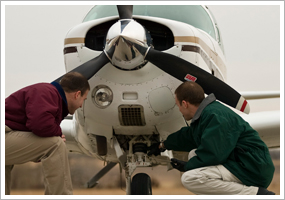| The following stories from the November 13, 2009, edition of AOPA ePilot were provided to AOPA members who expressed an interest in the particular subject areas. Any AOPA member can receive information tailored to their areas of interest by updating their preferences online. TRAINING TIPsGetting safety down cold
Going to be cold in the morning? Call the evening prior and ask to have your trainer placed in that nice, warm hangar—near the door—overnight. Don’t have the line crew yank it outside too early. It might still cool down and accrete frost.
Be sure you have reviewed your aircraft’s procedures for cold-weather engine starts and performed them under supervision by your flight instructor before going it alone. And here’s a question: What special safety considerations should be addressed during cold-weather starts? “During a cold-weather start, particularly on a carbureted engine, having a fire extinguisher nearby is not a bad idea,” AOPA Air Safety Foundation President Bruce Landsberg wrote in “ Industrial-strength preflight” in the February 2001 AOPA Flight Training.
You checked and confirmed that a fire extinguisher is present in the aircraft. Do you know how it works? Rod Machado discussed fire extinguisher dos and don’ts in the February 2003 AOPA Flight Training . (Robert N. Rossier discussed what to do if a fire does break out during startup in this article on AOPA Flight Training Online.)
An alternative to cold-weather starting is to schedule an engine preheat when you make that phone call to arrange your morning flight. And think about timing. Get that preheat when you are just about ready to fly. Then, don’t dawdle! It won’t take long on the ramp in a chill wind for the effectiveness of the preheat to be lost.
Aloft now, check the outside air temperature gauge regularly. Why? This is the time of year when freezing rain is more likely. If warmer air lies above below-freezing air (a temperature inversion) and rain starts, the precipitation could freeze upon striking the skin of an aircraft. Know the temperatures aloft, making special note of the freezing level, on that next fine flight of fall! TRAINING PRODUCTSASA instrument ground school gets high-def makeoverASA’s "Instrument Pilot Virtual Test Prep" has been revised and updated to include new content and high-definition video footage. The course is offered in widescreen format and includes both standard-definition DVD and high-definition Blu-ray discs, ASA said. Topics include weather concepts and services; flight instruments; navigation; regulations and procedures; departure, en route, arrival, and approach; and test tips. The ground school is designed to play on a television/computer DVD or Blu-ray player and is compatible with both PC and Macintosh DVD/Blu-ray systems. The course sells for $199.95 and may be ordered online.
Note: Products listed have not been evaluated by ePilot editors unless otherwise noted. AOPA assumes no responsibility for products or services listed or for claims or actions by manufacturers or vendors. FINAL EXAMQuestion: I'd like to use my Cessna 152 to get my instrument rating. For navigation equipment, the airplane has a single nav radio and VOR indicator. Can it still be used under instrument flight rules?
Answer: Yes, technically, it does meet the minimum requirements for IFR flight, since it is equipped in accordance with FAR 91.205 (d). According to the regulation, the aircraft is required to be equipped with “two-way radio communication and navigation equipment suitable for the route to be flown.” However, your Cessna 152 is not the best set-up for instrument training. While a single nav radio meets the requirements, you will likely find it difficult to complete an actual flight under instrument flight rules with such minimal equipment.
Got a question for our technical services staff? E-mail [email protected] or call the Pilot Information Center, 800/872-2672. Don’t forget the online archive of "Final Exam" questions and answers, searchable by keyword or topic. |
 With the cooling of the weather comes a seasonal change in aircraft operating procedures. Colder weather preparations to fly can be time-consuming; approach them with patience. If you’re the airport early bird who takes advantage of quiet times to fly, some simple strategic planning will speed you aloft.
With the cooling of the weather comes a seasonal change in aircraft operating procedures. Colder weather preparations to fly can be time-consuming; approach them with patience. If you’re the airport early bird who takes advantage of quiet times to fly, some simple strategic planning will speed you aloft.